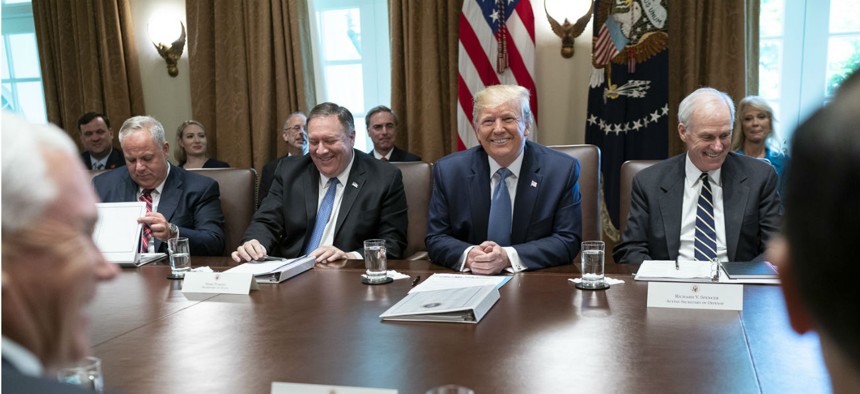
President Trump speaks with reporters during a Cabinet meeting on July 16. Of the record number of vacancies, the president has said he likes to have acting officials as a way of bypassing the confirmation process. Official White House Photo by Shealah Craighead
Agencies With Acting Leaders Can Now Fill Top Career Ranks, OPM Says
Some worry the administration is normalizing its proclivity for circumventing the confirmation process.
The Trump administration announced last week it will start processing new top-ranking senior executives even when their agencies are without a top leader, breaking from previous policy.
The move will hasten the process for onboarding members of the Senior Executive Service and enable agencies to respond to their most critical needs, acting Office of Personnel Management Margaret Weichert said in a recent memorandum. The move comes as the administration faces historic levels of vacancies filled by non-Senate-confirmed agency leaders and President Trump continues to boast he prefers “acting” leaders to avoid the confirmation process.
Weichert’s memo will enable OPM to continue to process Qualification Review Board cases even when an agency has a temporary chief. Previous guidance stipulated that agencies faced a moratorium on such reviews for SES candidates after their top leaders announced they were stepping down or the president announced a successor. The policy was intended to give an incoming leader more say in the top career ranks.
The ability to proceed with senior executive appointments is now automatic if the agency’s acting leader was a presidential appointee, with or without Senate confirmation. Boards, commissions and agencies with acting heads that are not presidentially appointed will receive authority to place SES candidates before review boards on a case-by-case basis.
Max Stier, president of the Partnership for Public Service, a group that tracks federal vacancies and helps agencies train career senior executives, said the move by OPM highlights the “untold stories and unintended consequences” of Trump’s reliance on acting leaders.
“The decision by OPM is recognition that there is a problem created by the volume of the vacancies,” Stier said, adding it “gums up the system multiple ways, including by preventing SES appointments.”
Stier added the policy change is a “reasonable response” to the current situation, but the “underlying problem is the number of vacancies.”
“We shouldn't have so many interim leaders,” Stier said. “In a world in which we do, it’s important to not compound the problem.” He added the administration should take care not to “normalize” its approach of high vacancy rates, frequent turnover and an increasing tendency to flout the Senate’s advise and consent role.
The moratorium will continue to take effect during an administration’s lame duck period, Weichert said. OPM last froze the hiring process for new SESers in December 2016, after Trump’s election but before he took office.
OPM did not respond to an inquiry regarding the purpose and timing of the policy change. In her memo, Weichert said the move was a practical one.
The guidance will provide agencies with “latitude as to merit staffing selection, in accordance with applicable regulations,” the acting OPM leader said. “This will also reduce burden to agencies and their SES time-to-hire, and create a more efficient process for agencies to respond to critical and exigent needs.”
NEXT STORY: Agencies Need More Flexibility to Fill Vacancies







